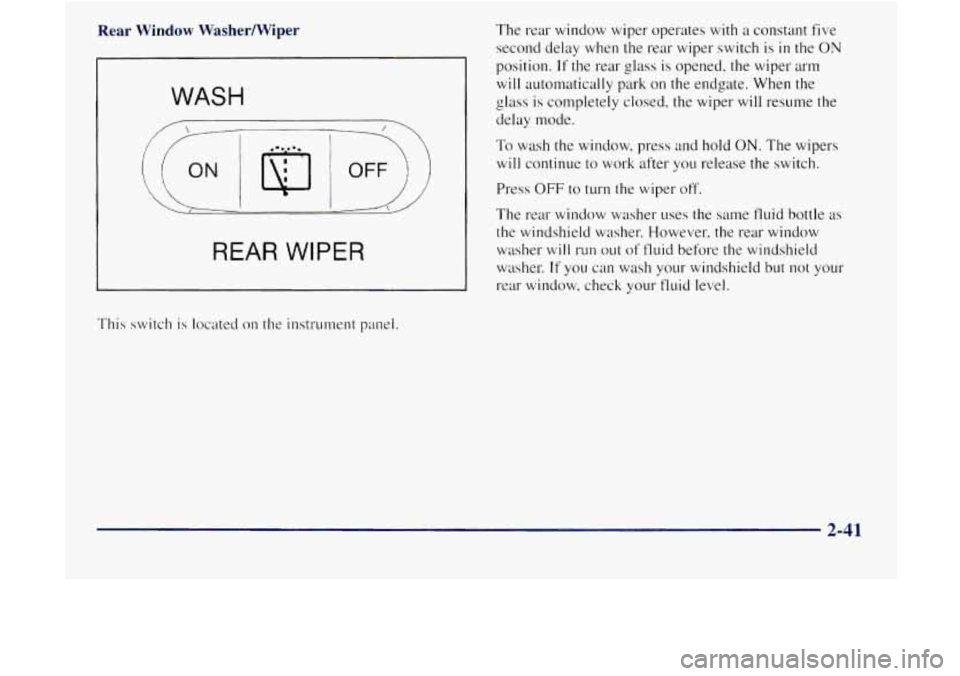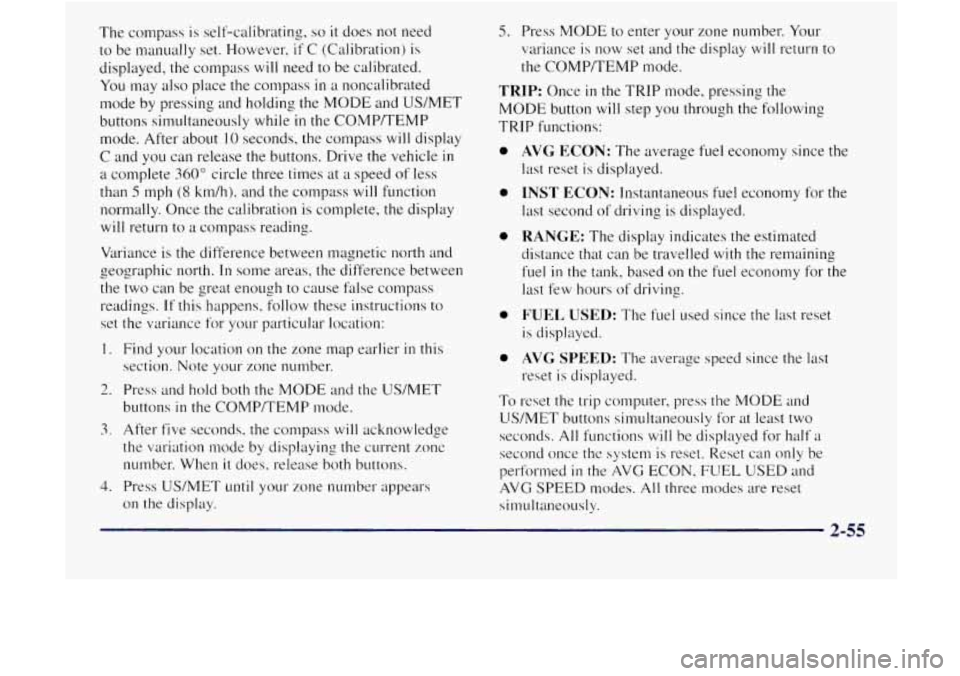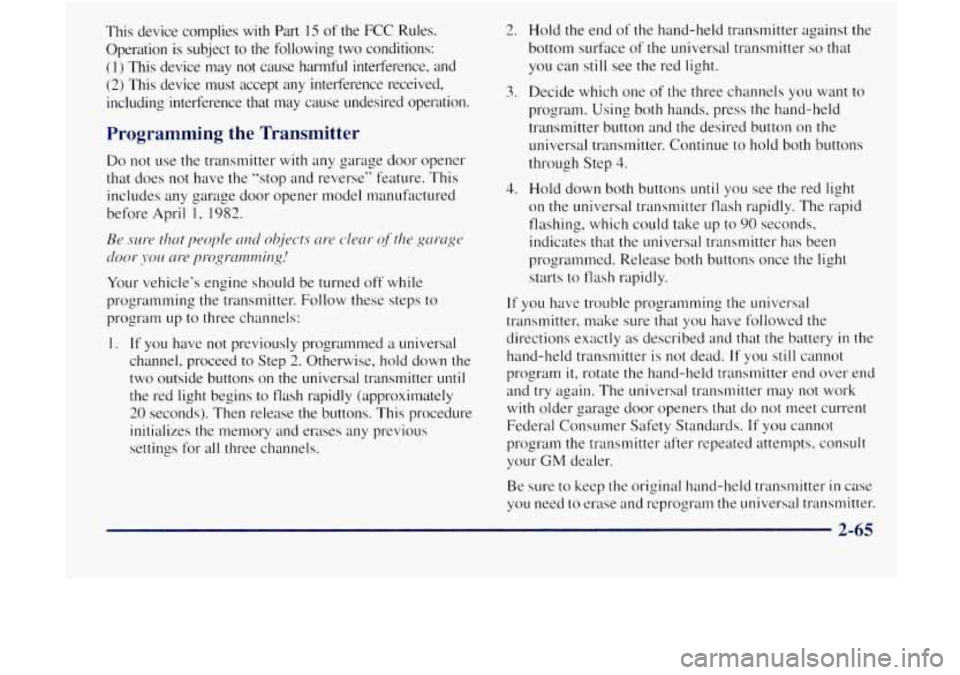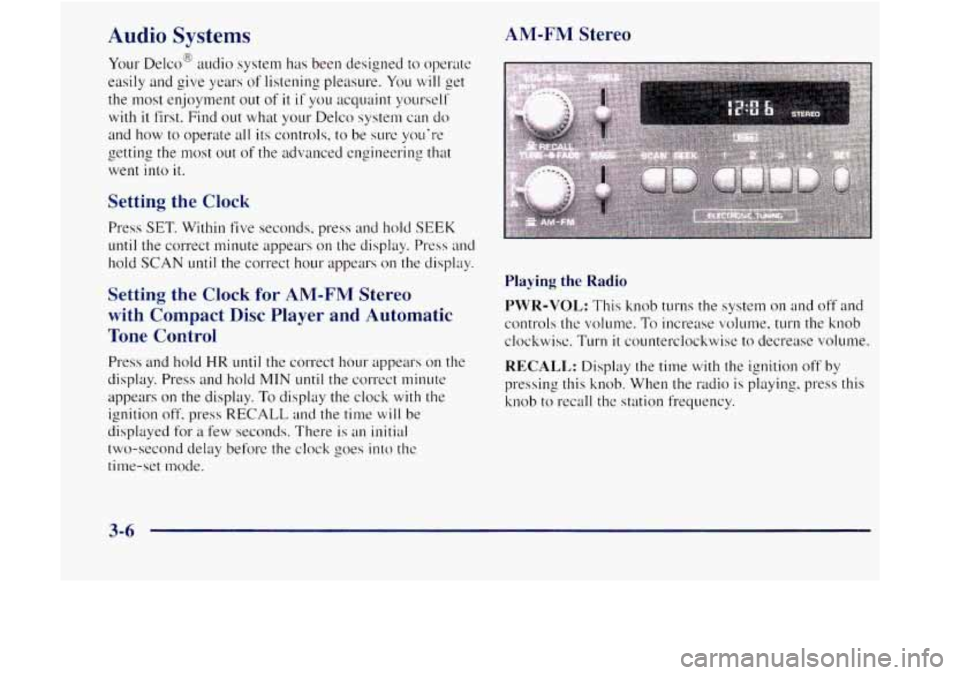ECO mode GMC JIMMY 1997 Owner's Manual
[x] Cancel search | Manufacturer: GMC, Model Year: 1997, Model line: JIMMY, Model: GMC JIMMY 1997Pages: 410, PDF Size: 20.03 MB
Page 102 of 410

Rear Window Washermiper
WASH
I I
OFF
REAR WIPER
This switch is located 011 the instrument panel. The
rear window wiper operates with
a constant five
second delay when the rear wiper switch is in the ON
position. If the rear glass is opened, the wiper arm
will automatically park on the endgate. When the
glass is completely closed, the wiper
will resume the
delay mode.
To wash the window, press and hold ON. The wipers
will continue to work after you release the switch.
Press
OFF to turn the wiper off.
The rear window washer uses the same fluid bottle as
the windshield washer. However, the rear window
washer will
run out of fluid before the windshield
washer.
If you can wash your windshield but not your
rear window, check your fluid level.
2-41
Page 115 of 410

R
Variance is the difference between magnetic north and
geographic north. In some areas, the difference between
the two can be great enough to cause false compass
readings.
If this happens, follow these instructions to set
the variance for your particular location:
I. Find your location on the zone map. Note your
zone number.
2.
3.
4.
5.
Press and hold both the ON/OFF and the US/MET
switches. The display will go off.
After five seconds,
VAR CAL will appear on the
display. When it does, release both buttons.
Press US/MET
until your zone number appears on
the display.
Press
ON/OFF to enter your zone number. Your
variance
is now set.
Driver Information System
(If Equipped)
This system displays the outside air temperature,
compass direction and trip information
in the
overhead console.
The USMET (United Statedmetric) button allows you to
switch the display between the English
and metric system.
The
MODE button can be used to toggle between three
modes
of operation: OFF, COMP/TEMP and TRIP.
OFF: This turns the system off.
COMP/TEMP: The display provides the outside
temperature
and one of eight compass readings to
indicate the direction the vehicle
is facing.
2 -54
Page 116 of 410

The compass is self-calibrating, so it does not need
to be manually set. However. if C (Calibration) is
displayed, the compass will need to be calibrated.
You may also place the compass
in a noncalibrated
Inode by pressing and holding
the MODE and US/MET
buttons simultaneously while
in the COMP/TEMP
mode. After about
10 seconds, the compass will display
C and
you can release the buttons. Drive the vehicle in
a complete 360" circle three times at a speed of less
than
5 mph (8 km/h), and the compass will function
nor~nally. Once the calibration is complete, the display
will return to a compass reading.
Variance is the difference between magnetic north and
the two can be great enough to cause false compass
readings.
If this happens. follow these instructions to
set the variance for your particular location:
I. Find your location on the zone map earlier in this
2. Press and hold both the MODE and the USNET
z oeographic north. In some areas, the difference between
section. Note your zone number.
buttons
in the COMP/TEMP mode.
3. After five seconds, the compass will acknowledge
the variation mode
by displaying the cuwent zone
number. When it does, release both buttons.
4. Press US/MET until your zone number appears
on the display.
5. Press MODE to enter your zone number. Your
variance is now set and the display
will return to
the COMP/TEMP mode.
TRIP: Once in the TRIP mode. pressing the
MODE button will step you through the following
TRIP functions:
0
0
0
0
0
To
AVG ECON: The average fuel economy since the
last reset is displayed.
INST ECON: Instantaneous fuel economy for the
last second
of driving is displayed.
RANGE: The display indicates the estimated
distance that can be travelled with the remaining
fuel
in the tank, based on the fuel economy for the
last few hours of driving.
FUEL USED: The fuel used since the last reset
is displayed.
AVCJ SPEED: The average speed since the last
reset is displayed.
reset the
trip computer. press the MODE and
US/MET butt& silnultaneously for at least two
seconds.
All functions will be displayed for half a
second once the system is reset.. Reset can only be
performed
in the AVG ECON. FUEL USED and
AVG
SPEED modes. All three modes are reset
silnultaneously.
2-55
Page 126 of 410

This device complies with Part 15 of the FCC Rules.
Operation is subject to the following two conditions:
( I ) This device may not cause harmful interference, and
(2) This device must accept any interference received,
including interference that may cause undesired operation.
Programming the Transmitter
Do not LIS~ the transmitter with any garage door opener
that does not have the ”stop and reverse’‘ feature. This
includes any garage door opener model manufactured
before April
1, 1982.
Re .WI-P tllcrt pwplt~ cml ohjucts c11-0 clmr of‘the g(it-cqe
cloo~. Jolr citxl I?t-~.’s”L“ll}”ill,s!
Your vehicle’s engine should be turned off while
programming the transmitter. Follow these steps to
program
up to three channels:
I, If you have not previously programmed a universal
channel, proceed to Step
2. Otherwise, hold down the
two outside buttons on the universal transmitter
until
the red light begins to flash rapidly (approximately
20 seconds). Then rekase the buttons. This procedure
initializes the memory and erases any previous
settings for all three channels.
2. Hold the end of the hand-held transmitter against the
bottom surface of the ~~niversal transmitter
so that
you can still see the red
light.
3. Decide which one of the three channels you want to
program. Using both hands, press the hand-held
transmitter button and the desired button on the
universal transmitter. Continue
to hold both buttons
through Step
4.
4.
Hold down both buttons until yo~r see the red light
on the Llniversal transmitter flash rapidly. The rapid
flashing, which could take up
to 90 seconds,
indicates that the universal transmitter has been
programmed. Release both buttons once the light
starts
to flash rapidly.
If you have trouble programming the universal
transmitter, make s~rre that you have followed the
directions exactly
as described and that the battery in the
hand-held transmitter is not dead.
If yo~t still cannot
program
it, rotate the hand-held transmitter end over end
and
try again. The universal transmitter may not work
with older garage door openers that do not meet current
Federal Consumer Safety Standards.
If you cannot
program the transmitter after repeated attempts. consult
your
GM dealer.
Be sure to keep the original hand-held transmitter in case
you need
to erase and reprogram the universal transmitter.
2-65
Page 149 of 410

Audio Systems
Your Delco@ audio system has been designed to operate
easily and give years of listening pleasure. You will get
the most enjoyment out
of it if you acquaint yourself
with it first. Find out what your Delco system can do
and how to operate all its controls, to be sure you're
went into it.
c eetting the most out of the advanced engineering that
Setting the Clock
Press SET. Within five seconds, press and hold SEEK
until the correct minute appears on the display. Press and
hold
SCAN until the correct hour appears on the display.
Setting the Clock for AM-FM Stereo
with Compact
Disc Player and Automatic
Tone Control
Press and hold HR until the correct hour appears on the
display. Press and hold
MIN lmtil the correct minute
appears
on the display. To display the clock with the
ignition
off, press RECALL and the time will be
displayed for a few seconds. There is an initial
two-second delay before the clock goes
into the
time-set mode.
AM-FM Stereo
Playing the Radio
PWR-VOL: This knob turns the system on and off and
controls the volume. To increase volume,
turn the knob
clockwise. Turn
it counterclockwise to decrease volume.
RECALL: Display the time with the ignition off by
pressing this knob. When the radio is playing, press this
knob to recall the station frequency.
Page 157 of 410

18
1.
2.
3.
4.
5.
PUSHBUTTONS: The six numbered pushbuttons let
you return to your favorite stations. You can set up to
6.
stations (six AM. six FM 1 and six FM2). Just:
Turn the radio on.
Press
AM-FM to select the band.
Tune
in the desired station.
Press
AUTO TONE to select the setting you prefcr.
Press and hold one
of the four pushbuttons. The
sound will
mute. When it returns. release the button.
Whenever
you press that numbered button, the
station
you set will return and the tone you selected
will be a~~tomatically selected for that button.
Repeat the steps
for each pushbutton.
P.SCAN: The preset scan button lets you scan through
your favorite stations stored
on your pushbuttons. Sele-ct
either the
AM, FMI or FM2 mode and then press
P.SCAN.
It will scan through each station stored on your
pushbuttons
and stop for ;I few seconds before
continuing to scan through a11
of the pushbuttons. Press
P.SCAN
again or one of the pushbuttons to stop
scanning to listen to a specific stored station. P.SCAN
will light up on the display while in this mode. If one of
the stations stored on a pushbutton is too weak for the
location you
itre in, the radio will skip the preset station
and the radio display will show the channel number
(PI through
P6) for several seconds before advancing to
the next preset station.
Page 159 of 410

If the disc comes back out and ERR appears on the
display.
it could be that:
You are driving on a very rough road. (The disc
should play when the road gets srnoother.)
The disc is upside down.
It is dirty. scrutchect or wet.
0 It is very humid. (If so, wait about an hour and try
again.)
The disc player is very hot.
Press RECALL to make ERR
go off the display.
PREV (1): Press PREV or the SEEK left arrow to
search for the previous selection. If you hold this button
or press
it more than once, the disc will advunce further.
Sound is muted
in this mode.
RDM (2): Press this button to play the tracks on the disc
in random: rather than sequential, order. While in the
RDM mode, RANDOM appears on the display. Press
RDM again to return to normal play.
NEXT (3): Press NEXT or the SEEK right arrow to
search for the next selection. If you hold this button or
press
it more than once, the disc will advance further.
The next track number
will appear on the display. Sound
is muted in Illis mode.
REV (4): Press and hold REV to return rapidly to a
favorite passage. You will hear- the disc selection play at
high speed while
you press the REV button. This allows
you
to listen and I'ind out when the disc is at the desired
selection. Release REV
to resume playing.
FWD (.6): Press and hold this button to advance rapidly
within ;I track. You will hear the disc selection play at
high speed while you press the
FWD button. This allows
you to listen and find out when the disc is at the desired
selection. Release
FWD to resume playing.
AM-FM: While in the CD Inode, press this button to
stop playing the CD and play the radio. The CD symbol
will still display but the word CD will be replaced with
either AM. FM I or FM2. (If the radio is turned off, the
disc stays in the player and will resume playing at the
point where it stopped.)
RECALL: Press this button to see what track is playing.
Press
it again within five seconds to see how long the
CD has been playing that track. Elapsed time is
displayed in minutes and tenths of a second. The track
number
will also appear when a new track begins to
play. Press RECALL again to return to the time display.
3-16
Page 291 of 410

Brake Pedal Travel
See your dealer if the brake pedal does not return to
nor~nal height, or
if there is a rapid increase in pedal
travel.
This could be a sign of brake trouble.
Brake Adjustment
Every time you make a brake stop, your disc brakes
adjust for wear.
If your brake pedal goes down farther than normal. your
rear drum brakes may need adjustment. Adjust them
by
backing up and firmly app1yin.g the brakes a lew times.
Replacing Brake System Parts
The braking system on a modern vehicle is complex. Its
many parts have to be of top quality and work well
together
if the vehicle is to have really good braking.
Your vehicle was designed and tested
with top-quality
GM brake parts. When
you replace parts of your braking system
-- for
example, when your brake linings wear down and you
haw to have new ones
put in -- be sure you get new
approved
GM replacement parts. If you don’t, your
brakes may
no longer work properly. For example, if
someone puts in brake linings that are wrong for your
vehicle, the balance between
your front and rear brakes
can change
-- for the worse. The braking performance
you’ve come to expect can change
in many other ways if
someone puts in the wrong replacement brake parts.
Battery
Every new vehicle has a Delco Freedom@ battery. You
never have to add water to one of these. When it’s time
for a new battery, we recomlnend a Delco Freedom
battery. Get one that has the replacement number shown
on the original battery‘s label.
6-32
Page 400 of 410

Methanol .................................... 6-4
Mirrors
....................................... 2-49
Convex Outside
.............................. 2-50
Inside Day/Night Rearview
..................... 2-49
Outside
..................................... 2-49
Visor Vanity
................................. 2-62
Model Reference
................................. vi
Mountain Roads ................................ 4-35
Multifunction Lever
............................. 2-38
Net. Convenience
.............................. 2-57
Neutral
Automatic Trans~nission
....................... 2- I9
Manual Transmission
.......................... 2-22
New Vehicle "Break-In"
......................... 2- I3
Nightvision
................................... 4-28
Normal Maintenance Replacement Parts
............. 6-63
Odometer
.................................... 2.68
Off-Road Driving .............................. 4- 15
Off-Road Recovery
............................. 4- I 1
Opener, Garage Door ............................ 2-5 1
Ordering Owner and Service Publications ....... 8- 11. 8- 12
Outside Mirror
Manual Adjust
............................... 2-49
Power Remote Control
......................... 2-49
Convex
..................................... 2-50
Overdrive, Automatic Transmission
................ 2-20
Oil.
Engine
..................................... 6-9 Overhead Console
.............................. 2-50
Overheating Engine
............................. 5-12
Owner Checks and Services
....................... 7-46
Owner Publications
........................ 8-11 .
Paint Spotting. Chemical ........................ 6-56
Park
Automatic Transmission
....................... 2-18
Shifting Into ................................. 2-30
Shifting Out of
............................... 2-33
AtNight
.................................... 2-12
Brake ...................................... 2-29
Brake Mechanism Check
....................... 7-49
Lots ....................................... 2-12
On Hills with a Trailer ......................... 4-52
Over Things That Burn
........................ 2-34
Your Vehicle. Manual Transmission
.............. 2-33
Passing
....................................... 4-12
Payload
....................................... 4-44
Periodic Maintenance Inspections
.................. 7-50
Power
Accessory Outlets
............................ 2-63
DoorLocks
................................... 2-5
Remote Control Mirror
........................ 2-49
Steering
..................................... 4-9
Steering Fluid
................................ 6-26
Windows
................................... 2-36
Powerseat ..................................... 1-3
Lumbar Controls .............................. 1-4
Parking
9-7